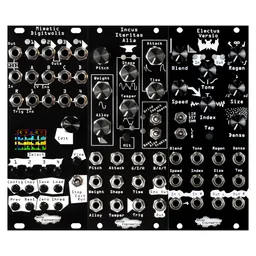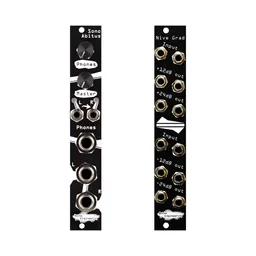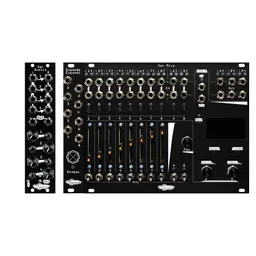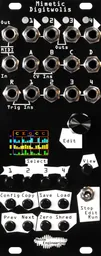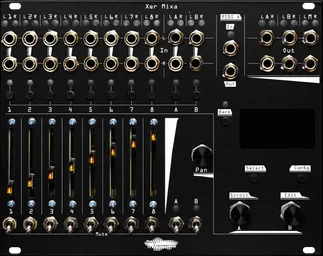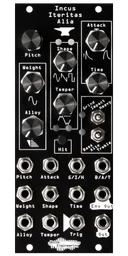We have an extensive lineup of Eurorack offerings with modules to suit nearly any application, but we get a lot of questions from folks starting out (and even highly experienced people!) about what modules they should get to complement each other. Today, in Part 1 this series, we’ll show off some of our favorite pairings (and trios). If you’re just starting out, or are looking to expand the capabilities of your Eurorack system, this is the place to look!
This video features all four of these suggested bundles, showing off what they can do. Jump between chapters to check out each setup!
Starter Bundle

This trio of modules is a fantastic starting point for a new Eurorack system: a full-fledged sequencer, an incredibly versatile synth voice, and a hybrid delay/reverb – with flexible firmware options to change the sound of your system on a whim.
Many of our classic sequencing options are designed to integrate into a larger sequencing system, creating something greater than the sum of its parts. That’s still the case with Mimetic Digitwolis, but it can also work 100% independently – no clock or other utilities needed. In this set of modules, Mimetic Digitwolis can output trigger signals to activate the synth voice, pitch CV to create melodies, and modulation CV to bring the patch to life.
Speaking of that synth voice, Incus Iteritas Alia is a hard-hitting percussion-oriented voice that’s a wonderful choice for kicks and metallic timbres, while also covering bass and lead sounds, fitting well into any application. Alia modules can also have their firmware reflashed to a variety of different synth voices and oscillators, offering seven different sound sources in one compact package.
Finally, Electus Versio adds atmosphere and delay, with clock-syncable reverb effects and echoes. Electus can act as an instrument all on its own, creating playable atmospheres that never decay with feedback past 100%. Versio is also a platform, allowing the module to act as a huge variety of effects from delays and reverbs to dynamics processing and distortion – and more.
Rhythm Bundle

If you have a few percussion voices in your system, this set of modules offers all the sequencing you need: trigger and accent gate generation, plus loopable melodic or modulation CV. Patch in a clock and you’re ready to go!
Zularic Repetitor is a classic in our lineup: from one clock signal, you get four rhythmic outputs that can be dynamically played using the pots, or modulated with CV (or both!). It’s the simplest way to play a rhythm – patch the outs to your drum voices, and adjust the parameters until you hear something you like.
Confundo Funkidos adds a performative layer to any trigger sources. Each channel has two trigger inputs, a trigger output, and an algorithmically generated accent output. Four mute switches control the outputs of the channels, and a crossfader flips and mixes between the left and right columns of trigger ins. Inspired by DJ mixers but applied to trigger signals, Confundo Funkidos is a unique utility that shows the real power of Eurorack patching.
Finally, Gamut Repetitor generates random loopable pitch CV and randomized trigger patterns on four pairs of outputs. For a simple patch, route a clock to the top input, pick a scale with the switches, and turn up Spread and Length. Gamut Repetitor will generate pitch and trigger signals on all four channels, and once you hear something you like, turn Length down to loop the last number of steps. When you want a new pattern, just turn up Length again, or jam on the generative parameters to change how your pattern sounds.
Try patching the outs of Zularic Repetitor to the left side of Confundo Funkidos, and the trigger outs of Gamut Repetitor to the right side. Then, patch the Trigger and Accent outs from Confundo Funkidos and the Pitch outputs from Gamut Repetitor to four voices in your system, and you’ve got a dynamically generated sequencing system ready for your next performance!
Performance Modulation Bundle

Speaking of performance, Lapsus Os is a simple and handy utility that can act as a performance macro in your patches. It features four channels, each with an attenuation input, offset input, voltage switch, two multed outputs, and control fader. With nothing patched in, each channel can generate a 0V to +5V or -5V to +5V offset, useful for adjusting multiple parameters with one control. Stephen’s been using this technique to great effect in his performance jams, with one fader patched to the decay times of all the voices in his system.
Things get even more fun when you mix in external signals, too. Try patching the four CV outputs of Mimetic Digitwolis to the attenuation inputs on Lapsus Os, then use the multed outs to route them to timbral destinations in your patch. Then, use the faders on Lapsus Os to increase and decrease modulation on the fly.
Mix Bundle

If you have a system with more than a few voices, you’ll know how important a performable mixer is for a patch. Xer Mixa is the answer to all of your mixing needs, with 10 pairs of stereo inputs (yes, 10 pairs!), and three pairs of stereo outputs, all combined in a low-noise, high-headroom analog summing mixer. With faders and mutes for each channel, two effects loops, MIDI control, and flexible routing, Xer Mixa has studio-level routing capabilities and all-analog sound with a compact footprint and digitally-controlled flexibility.
The Expando Expandi expander adds 8 CV inputs, which can be mapped to up to 32 destinations in the Xer Mixa. One CV input can control multiple destinations for complex modulation routing, and destinations include almost all editable parameters in the mixer.
With a big mix, it can be nice to have some dynamics processing and gentle color applied to the output. Enter Librae Legio, which can apply stereo compression, noise gating, limiting, and two types of master-appropriate distortion with a simple interface. It’s the perfect glue for a full mix, or, with more aggressive settings, drum bussing and instrument processing. Librae Legio can also be reflashed and used as a stereo filter, distortion, oscillator, and more.
What’s right for you?
The beauty of Eurorack is its flexibility: each of these bundles can act as a great starting point for a particular goal, and will grow with your system as you expand in different directions. If you’re still looking for the perfect solution to your next patch, keep an eye out for future posts in this series, and drop us a line for personalized suggestions!
